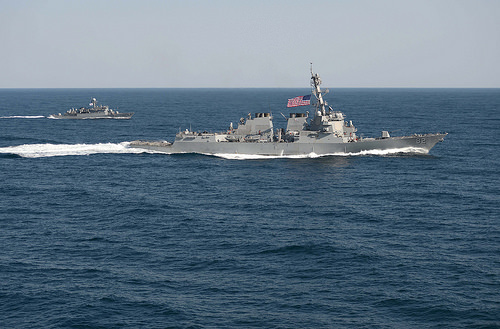
The USS Lassen, which sailed through Chinese-claimed waters in October 2015
WASHINGTON: The United States will keep challenging Chinese claims in the South China Sea, the head of Pacific Command said this afternoon. Such Freedom of Navigation operations will grow in frequency, complexity, and scope, said Adm. Harry Harris. And Harris defended the first such FON operation” since 2012, last October’s cruise of the destroyer USS Lassen through Chinese-claimed waters around an artificial island, Subi Reef. It was not the empty gesture critics have claimed, he argued.
“As we continue down the path of freedom of navigation operations, you will see more of them and you will see them increasing in complexity and scope,” Harris said when I raised the question at a Center for Security and International Studies forum. “In general, we will continue to do freedom of navigation operations in the South China Sea as we do everywhere else in the world.”
In fact, though, the Navy acknowledged last September there had been a three-year gapin FONOPS asserting US rights to sail, fly, and conduct military activities in Chinese-claimed areas of the much-disputed South China Sea. Then came the Lassen mission, which sent the destroyer within 12 nautical miles of territory claimed by not only China but also China’s old enemy Vietnam, America’s old ally the Philippines, and America’s unofficial ally Taiwan. The US did not notify any of the nations in advance that Lassen was coming, which particularly ticked off the Chinese.
But the ship just sailed through the 12-mile zone without conducting any specifically military activity — which international law allows in territorial waters under the principle of “innocent passage.” By contrast, warships may not conduct military operations in another nation’s 12-mile territorial waters: If the Lassen had diverted from a straight course to, for example, conduct training with its targeting radars, that would have demonstrated that the US didn’t consider the disputed areas territorial waters at all. By limiting itself to what the Pentagon itself says was merely an “innocent passage,” the Lassen didn’t actually challenge China’s claim that the area around its artificial islands is territorial waters.
Harris argued the Lassen still made an important stand for international law. “I believe that the Lassen operation did challenge some aspects of China’s claims,” he said, “for example, the requirement to give prior notice before you do innocent passage.” (See Sec. Ash Carter’s official explanation here).
It’s crucial to note that Beijing has its own, rather unique interpretation of international law. There is “no freedom of navigation for warships and [military] airplanes,” said China’s ambassador to the Philippines, Zhao Jianhua, back in August. When an American P-8 maritime patrol plane — with a CNN reporter aboard — flew past a Chinese artificial island in May, the Chinese ordered it to leave their airspace. When P-8s and the older P-3s have flown surveillance missions near China’s Hainan Island in the past, Chinese fighters have scrambled for sometimes dangerously close interceptions. In the face of the Lassen to assert even the baseline right of “innocent passage” through territorial waters is arguably an accomplishment.
“They are pretty rigid in their view of their ownership of the islands in the South China sea and all the resources hat can be gained from them [e.g. oil, gas, and fisheries],” said Harris. In a trip last fall to China, he said, “I made clear my view, my personal view, that those islands do not belong to China and that the land reclamation activities [i.e. island building] were increasing the tensions in the region and the Chinese actions were provocative.”
The US takes no position on who owns what island in the disputed waters, but it takes a strong position that an artificial structure isn’t legally an island at all. “We debated that quite strenuously,” Harris said.
Harris did not expect tensions to let up. Yes, he continues to work on reducing tensions with the People’s Liberation Army. Yes, China contributes positively to global concerns like counter-piracy. Yes, China is halting its island building in the South China Sea.
But, the admiral said, the Chinese Coast Guard continues to build a mammoth “cutter” displacing 12,500 tons — a quarter more than a US Arleigh Burke destroyer — with a bow reinforced for ramming. Since the Chinese Coast Guard has played aggressive bad cop to the PLA Navy’s good cop in disputed waters, the construction of such a ship suggests Philippine, Vietnamese, or Japanese coast guard vessels are going to take some hard hits in the near future.
The US has specifically stated its treaty obligations to defend Japan would apply to an attack against the disputed Senkaku Islands, known to China as the Diaoyus, Harris reminded the audience. (The US has no position on who owns the islands, but Japan has administered them for decades). And the US is working to enhance its relationships with partners around the region, he said: a new defense agreement with the Philippines to allow the US to use and upgrade bases there; Marines and in future Air Force squadrons operating out of Australia; both exercises and arms deals with India. He also hopes — perhaps against hope — that South Korea and Japan will overcome their deep historical animosity to work together “trilaterally” with the US, instead of in two separate-but-equal one-on-one relationships as exist now.
Despite China’s rapidly growing numbers and advancing technology, Harris said, the US still has many “asymmetric” advantages. One of them, he said, is that we have friends in the Asia-Pacific region and they don’t.
No comments:
Post a Comment